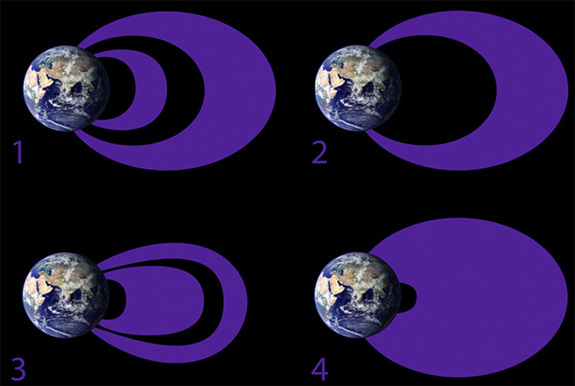
Artist’s impression of NASA’s Van Allen Probes mission studying Earth’s radiation belts.
Credit: NASA
Satellites can short-out if they encounter a surge of radiation in Earth orbit and a new study of the Van Allen belts’ shape — an intensely charged region surrounding our planet — could help better protect them from this highly-charged environment, researchers say.
PHOTOS: Epic Auroras Throughout the Solar System
Astronauts in orbit are mostly protected from the Van Allen belts as these radiation-filled volumes start at 600 miles above the Earth’s surface — generally, astronauts in low-Earth orbit travel around 250 miles high. These belts extend as far as the altitude of geosynchronous satellites, at 25,000 miles. We’ve known this for decades, but scientists have just found a new link between charged particle (specifically electrons) behavior and the shape of the belts.
“The shape of the belts is actually quite different depending on what type of electron you’re looking at,” said lead author Geoff Reeves, of Los Alamos National Laboratory’s intelligence and space research division, in a statement. “Electrons at different energy levels are distributed differently in these regions.”
ANALYSIS: Raise Shields! Star Trek-Like Barrier Protects Earth

The shape of the Van Allen belts can vary widely depending on how energetic the individual electrons are, and general conditions in the Earth’s magnetic environment. During geomagnetic storms (4), all three regions in the belts can balloon.
Credit: NASA GODDARD/DUBERSTEIN
ANALYSIS: Space Radiation Probes Make ‘Shock’ Discovery
The belts were discovered by Explorer 1, the first American satellite that went into space in 1958. They are named after James Van Allen, the space scientist who designed a cosmic ray instrument on that satellite. (He detected fewer cosmic rays than expected and suggested it may be due to radiation belts, which were confirmed in a later mission.) The belts’ shape changes depending on many factors, such as if the sun has recently sent a solar flare that hit the Earth’s magnetic environment.
Initially, scientists built up a very simple picture of the belts: a small inner belt, an empty space (called the “slot region”), and an outer belt that has a lot of electrons and is highly changeable.
NEWS: Probes Launched Into Earth’s Radiation Zone
The new research shows that these belts change frequently. If there’s a big solar storm, for example, the region merges into one large belt. Sometimes you’ll see a large inner belt and a small outer belt. Sometimes there will be an outer belt, but no inner belt at all.
There also are different energies of electrons throughout the belts. The inner belt has more electrons with low energies (generally) while the outer belt usually has more electrons with high energies. The level of electron energy varies with geomagnetic storms, causing the belts to dynamically change size and shape with respect to one other.
Launched in 2012 , the current NASA Van Allen Probes are able to measure more levels of electron energy than previously detected, both because of their sensitive instruments and position above the atmosphere. With more study, scientists are hoping to start building a better picture of how the Van Allen belts change, with an eye to protecting satellites.
The study was published in the Journal of Geophysical Research.
Originally published on Discovery News .

Comments are closed.